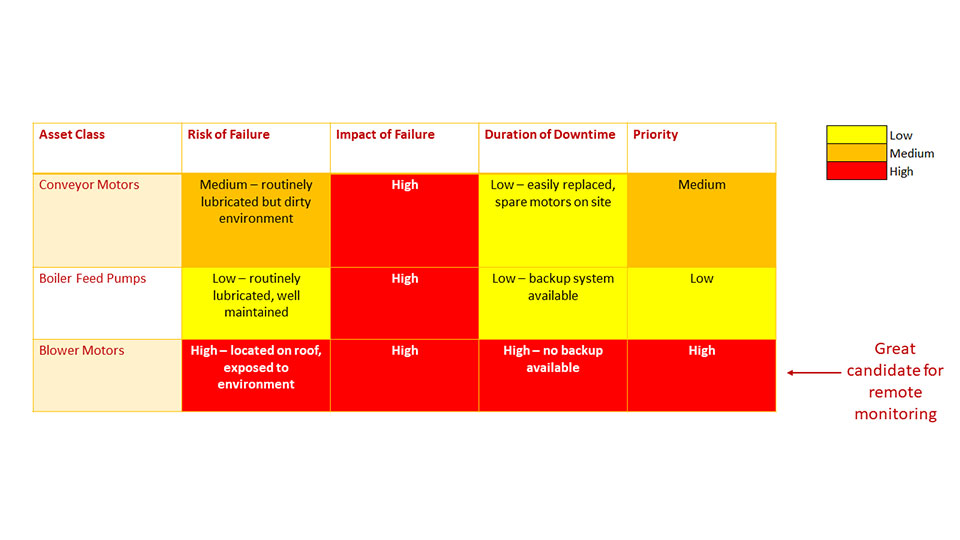September 26, 2019
Remote condition monitoring can dramatically improve operational equipment effectiveness (OEE), particularly in terms of reducing downtime. With granular, real-time insights into equipment health, organizations can transition into predictive maintenance, better utilizing staff hours, avoiding catastrophic failure, and maximizing use of equipment before replacement. As with all promising technologies, the devil is in the details. In the case of remote condition monitoring, success begins before deployment, with the selection of equipment to be monitored.
When managing multiple production lines and a variety of critical equipment, it can be challenging to determine which assets should be prioritized for remote conditioning monitoring. After all, not all equipment is critical and not all downtime will be extensive. Don’t aim to deploy on all assets across the factory floor. Instead look for low hanging fruit that will demonstrate immediate value and provide quantifiable results. Early success in a remote condition-monitoring program will pave the way for broader deployment of the technology and greater benefit to the organization.
In this article, we will discuss how to take inventory of potential candidates and three key factors to determine prioritization when selecting assets for remote conditioning monitoring: risk of failure, impact of failure and duration of downtime.
The first step in identifying the best candidates for remote condition monitoring is to conduct a detailed audit of assets. There are several classes of assets that should be considered:
Assets that are critical to operations¾can a failure stop operations?
Troubled assets¾do they already demonstrate defects?
Assets that have been replaced previously¾is there a likelihood of future failures?
Assets that are difficult/expensive to replace¾do assets require specialty equipment? Do replacement parts require long lead time?
Remote and hard-to-reach assets¾are they in restricted, hazardous, or simply difficult locations?
Once the audit is complete, the assets should be ranked in terms of three factors:
Risk of failure
Start with assets with a history of failure. How often do those failures occur? If assets don’t have a detailed history, review the particulars of the application. Is equipment deployed in a harsh environment such as high moisture, high contamination, heavy shock and vibration, corrosive chemicals, extreme temperatures etc.? Does it operate at high loads or high duty cycles? All of these factors will increase the likelihood of failure.
Impact of failure
Remote condition monitoring has traditionally been reserved for assets that carry high cost of replacement, such as electrical turbines. A blower or pump costing a few hundred dollars wasn’t considered valuable enough to justify the outlay or effort. That way of thinking overlooks a key point, however, which is that the failure of that blower may shutdown other production equipment, which can scale its value considerably.
As an example, consider a manufacturer of food-grade paper packaging products. The primary paper line supplied most of the other converting machines on the factory floor. When the bearing on one of the lines rollers failed as a result of 24/7 use in a harsh environment, that single component could essentially shut down most of the operation. As a result, downtime cost $10,000 per hour or more and could last multiple days. These numbers quickly justified the investment in remote condition monitoring, particularly given the recent emerging class of economical, easy-install monitoring equipment.
Duration of Downtime
Duration of downtime can be affected by a number of factors. Start with the nature of the failure. Replacing an asset that has undergone catastrophic failure takes significantly more time than swapping out the troubled asset just before an event. The actual repair process represents just a part of overall downtime. Replacement parts that involve long lead time as a result of customization or limited supply can extend downtime, unless a (potentially costly) spare is maintained in inventory. The need for special equipment also can be a factor. Changing a rooftop asset might require a crane that adds hours or days to rent and bring on site. The need for skilled labor might add hours more.
Once you’ve tabulated these three factors, prioritize assets to determine their suitability for inclusion in a remote condition monitoring program (see table). A well-maintained boiler feed pump might have a low priority ranking despite high impact of failure because it can be easily switched to a backup system. In contrast, a rooftop blower motor might be classed as high risk because of its location, environmental conditions, and lack of backup system.

Table 1: Example of prioritizing assets for remote monitoring
Combined with strategic deployment, today’s remote condition monitoring systems can dramatically boost OEE and productivity while reducing costs. Strategic monitoring maximizes the value of the technology while optimizing the overall performance of the facility. In the case of a pilot program, it increases the likelihood of rapid success, thus making the case to extend the program across the organization.

Abhishek Jadhav
About the author
Abhishek Jadhav, a Mechanical Engineer, and Category II Vibration Technician, has extensive experience in the design and development of heavy-duty industrial products including rotary encoders and vibration monitoring systems. Abhishek holds a master’s in mechanical engineering from the University of Alabama in Huntsville, and currently pursuing his MBA from Wisconsin School of Business, Madison. Abhishek joined Dynapar in 2010 as a mechanical engineer and has held various engineering roles of increasing responsibility with Dynapar. Prior to joining Dynapar, Abhishek worked at Caterpillar where he designed and developed common rail fuel injectors used in on- & off-highway trucks and power generators.
Scott Ellyson, CEO of East West Manufacturing, brings decades of global manufacturing and supply chain leadership to the conversation. In this episode, he shares practical insights on scaling operations, navigating complexity, and building resilient manufacturing networks in an increasingly connected world.